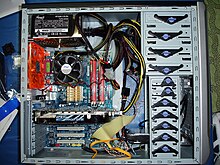White box (computer hardware)

In computer hardware, a white box is a personal computer or server without a well-known brand name.[1] For instance, the term applies to systems assembled by small system integrators and to home-built computer systems assembled by end users from parts purchased separately at retail. In this latter sense, building a white box system is part of the DIY movement.[2][3] The term is also applied to high volume production of unbranded PCs that began in the mid-1980s with 8 MHz Turbo XT systems selling for just under $1000.[4]
In 2002, around 30% of personal computers sold annually were white box systems.[3] Although saving money is a common motivation for building one's own PC, today it is generally more expensive to build a low-end PC than to buy a pre-built equivalent.[5][6][7][8]
Operating system[]

While PCs built by system manufacturers generally come with a pre-installed operating system, white boxes from both large and small system vendors and other VAR channels can be ordered with or without a pre-installed OS. Usually when ordered with an operating system, the system builder uses an OEM copy of the OS.
Whitebook or Intel "Common Building Blocks"[]
Intel Corporation defined form factor and interconnection standards for notebook computer components, including "Barebones" (chassis and motherboard), hard disk drive, optical disk drive, LCD, battery pack, keyboard, and AC/DC adapter. These building blocks are primarily marketed to computer building companies, rather than DIY users.
See also[]
- Beige box
- DIY ethic
- Homebuilt computer
- White-label product
References[]
- ^ Ross, John; Murdock, Kelly L. (2007-03-12). PC User's Bible. John Wiley & Sons. ISBN 978-0-470-08897-5.
- ^ Buying a Non-Branded "White Box" PC InformIT, May 7, 2004
- ^ a b Dell eyes 'white box' market CNET News, August 20, 2002
- ^ Inc, InfoWorld Media Group (July 7, 1986). "InfoWorld". InfoWorld Media Group, Inc. – via Google Books.
- ^ "Is Building a PC Really Cheaper than Buying One?". Lifehacker.
- ^ "The Perfect PC: Don't Buy It, Build It".
On a $500 budget, PC manufacturers have a clear advantage: By ordering in bulk and maintaining direct control over their supply chain, they can buy components at lower prices than can an individual user shopping for parts online.
- ^ "Does it still make sense to build your own computer?".
Woot had a refurbished HP desktop that was packed to the rafters with high-end hardware -- all for $469.99. There's simply no way you could piece together a similarly equipped machine for less money; rather, it would likely cost you hundreds more -- and you wouldn't have the benefits of a whole-system warranty or tech support.
- ^ "The pros and cons of building your own computer".
Buying a PC from a manufacturer like HP, Dell, or Lenovo can be very cheap. Prices have been driven down to all-time lows (basic desktops and laptops now start at around $300) and you will have a device that just works, in most cases, out of the box. Not to mention that these computers also come with tech support and a warranty.
- Computer enclosure
- Electronics manufacturing
- Personal computers
- Computer jargon